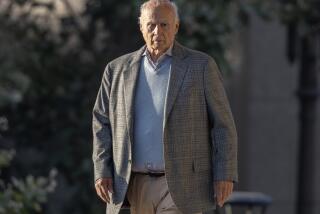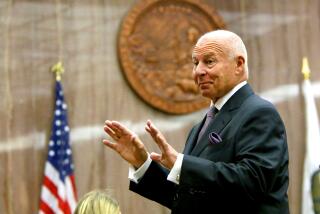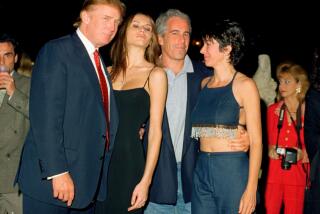From Financier to Fugitive. . . . . . to Defendant : J. David: A Year Later
- Share via
It has been nearly one year since J. David & Co. was thrown into bankruptcy. The events since last Feb. 13 have had a dramatic impact on San Diego--from the plight of the investors who lost upwards of $100 million to that of a young, ambitious mayor fighting for his political life.
In these five articles, Bill Ritter, Times San Diego County business editor, updates the status of the J. David bankruptcy case, the ongoing federal investigation and the people affected by the company’s problems.
Although Rogers & Wells didn’t have any money invested in J. David & Co., the large national law firm may eventually become one of the J. David affair’s biggest losers.
Rogers & Wells is being sued by former J. David investors who contend that the law firm’s actions contributed in part to their financial losses.
The lawsuits raise several complicated legal issues: How quickly should a law firm cease working for a client when it discovers improper and illegal activities, and how culpable is a law firm for the actions of one of its lawyers? Those issues will be hotly debated by civil lawyers and by federal prosecutors for months and perhaps years to come.
What seems clear is that if state regulators had known in early 1983 what Rogers & Wells attorneys knew, they might have nipped the scheme before it flowered into a $100-million fiasco, according to interviews with attorneys close to the case and a review of dozens of Rogers & Wells documents obtained by The Times.
Rogers & Wells attorneys, for example, huddled in London in mid-January of 1983 and concluded that J. David’s foreign currency trading accounts--the so-called interbank--should be registered, and they agreed to officially inform Dominelli of that determination. That was done on Feb. 2, 1983, by Rogers & Wells attorney Don Augustine, who advised Dominelli in a four-page memo that sales of his interbank accounts violated federal and state securities regulations. He told Dominelli that the accounts should not be sold unless and until they were registered with the government or given a registration exemption.
But the next day, Augustine met with George A. Crawford, corporate counsel for the state Department of Corporations, to discuss the state’s investigation of J. David’s trading activities. According to a Feb. 4 memo written by Augustine that detailed that meeting, the Rogers & Wells position on registering interbank apparently wasn’t mentioned.
In fact, Augustine wrote that it was Crawford’s opinion that J. David “individual discretionary accounts . . . were not a security . . . “
J. David’s interbank accounts were not individual and discretionary, with each investor instructing Dominelli where to transfer funds. Rather, J. David pooled its investors’ funds.
The difference is important because individual accounts do not require registration with the government as securities; pooled investment funds must be registered.
Rogers & Wells, according to sources familiar with the case, will argue that it was not hiding facts from regulators, but merely serving its client’s interests.
Other memos obtained by The Times show that Rogers & Wells advised J. David to reorganize so as to avoid government regulation.
On Oct. 5, 1982, for example, Rogers & Wells attorney Norman Nouskajian--who worked nearly full time with J. David--advised financier J. David (Jerry) Dominelli that his firm needed an organizational “face lifting” so that its trading activity could avoid government registration requirements.
In a different memo that day, Nouskajian advised Dominelli that brokers in J. David Securities Inc. could “receive a fee or commission” from referring clients to J. David’s interbank activity. The amount of the fee, wrote Nouskajian, “need not be disclosed nor need the fact of such payment be disclosed.”
But failure to disclose such fee payments violates federal securities laws, according to an attorney familiar with the case.
Nouskajian, through his attorney, declined to be interviewed. Rogers & Wells sources contend that Nouskajian often acted beyond the scope of the firm’s responsibilities at J. David.
“The Nouskajian memo of Oct. 5 makes the plaintiff’s case,” said one former J. David executive. “If the products are securities, then you need the (government’s) opinion as to whether they should be registered. That (the memo) isn’t how you’re supposed to practice law.”
Other attorneys at J. David did attempt to raise the red flag.
Former in-house counsel Fred Storm said he gave Nouskajian and Augustine “convincing evidence” that J. David was improperly selling interbank accounts.
“Mr. Augustine finally, within his firm, was able to circumvent Mr. Nouskajian’s obstruction efforts to force Dominelli to comply,” Storm said in an interview last week. “I had gone to Nouskajian . . . voicing my concerns. And Nouskajian was going around me directly to Mr. Dominelli . . . “
Frustrated, Storm resigned in May, but not before voicing his complaints to Rogers & Wells officials.
Interestingly, Rogers & Wells resigned from interbank work the next month. On June 2, 1983, the firm officially notified Dominelli that it would “not render any . . . opinions” about J. David’s interbank activities.
The memo, written by Mitchell L. Lathrop, Rogers & Wells’ managing partner in San Diego, tells Dominelli to “look to other counsel for opinions which may be required” for interbank.
Nouskajian, however, continued to represent J. David, including interbank, recalled former executives.
Moreover, Rogers & Wells received thousands of dollars in fees from J. David throughout the rest of 1983.
Why, some lawyers close to the J. David case have asked, did it take so many months for Rogers & Wells to officially resign from interbank when they suspected all along that there might be problems?
Officials at Rogers & Wells--which received as much as $900,000 in legal fees from J. David, according to one source familiar with the case--would not comment on that or any other aspect of the case, citing pending litigation.
However, a Rogers & Wells source said that the firm constantly but unsuccessfully asked Dominelli to produce his records. A memo obtained by The Times, for example, shows that Augustine planned to examine interbank’s numbered accounts during the week of April 25, 1983.
“We asked the question, but we never received the answer,” said the source. “We kept saying, ‘What about this, what about that?’ and finally we just said, ‘That’s it, guy, goodby.’ ”
That version has been questioned by some investors who have named the Laventhol & Horwath accounting firm in their lawsuits. The firm relied on verifications by Nouskajian of interbank’s solvency when it audited the J. David group of companies, according to a Laventhol & Horwath source.
“The first thing I would have done was to go to the back office and ask for a breakdown of the accounts on an individual basis,” said Nicholas F. Coscia, a former Securities and Exchange Commission enforcement attorney who served as J. David’s general counsel in January, 1984, the month before the firm’s collapse.
It was Coscia who, on the job only for about one month, told Rogers & Wells on Feb. 9, 1984, that J. David “may be selling unregistered securities.”
“If (Dominelli) doesn’t show the records (when asked by auditors), then walk away, because you know he’s hiding something,” said Coscia. “I wouldn’t have continued the legal work in the dark; I would have done more probing.”
More to Read
Inside the business of entertainment
The Wide Shot brings you news, analysis and insights on everything from streaming wars to production — and what it all means for the future.
You may occasionally receive promotional content from the Los Angeles Times.









